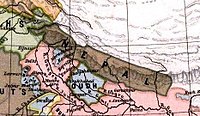|
Naya Muluk
 Naya Muluk (Nepali: नयाँ मुलुक) is a geographical region of Nepal, which is situated western-south part in Nepal. The Terai land between Kali River to Rapti River called "Naya Muluk" after 1860.[1][2] HistoryAfter Anglo-Nepalese War in 1814–1816, Nepal was forced to sign a treaty called Sugauli Treaty in which Nepal lost one third part of geographical territory. The geographical territory was sectioned in five parts as below:
Section: 2 and 3 (whole land from Rapti to Gundak and Gandak to Koshi) restored back to Nepal on December 11, 1816. Section: 1 (whole low land between the Rivers Kali and Rapti) returned in 1860 called Naya Muluk. Territory Naya muluk contains two district of Sudurpashchim province and two district of Lumbini Province. Total area is 9,207 square kilometres (3,555 sq mi) and total population is 2144,846.
References
External links
|
